 |
||
| October 2, 2006, Deekshabhumi, Nagpur, where Dr. Ambedkar converted in 1956. | ||
Journey to the Center of India, 2006, Part 1, November 6, 2006
Some years ago, we saw an ad in a newspaper: "Come to India for a restful vacation!" That has been a standing joke with us since that time. Over the years, we have spent more than twelve months in India. We can vouch that India, at least the way we travel, does not offer a "restful vacation." It is hard work. Leaving the delightful temperatures of Kandy was painful, knowing that we were going to Nagpur, where it was averaging 36 degrees C.
Rather than stay overnight in Colombo, as we have always done in the past, we asked Chanda to drive us directly to the airport. Halfway to Colombo, the route veered off the Kandy Road, and the two-lane road passed through small villages and lots of greenery. We soaked up as much of the pastoral serenity as we could, expecting that India was going to be quite different.
For the first leg of our trip, the flight to Chennai, we were upgraded to Business Class. Most of our fellow passengers were elderly Sri Lankan pilgrims bound for the sacred sites. They were a cheerful and care-free bunch, much like some tour groups we had known from Japan. They all responded to our smiles with smiles, but few spoke enough English to carry on a conversation.
The transfer in Chennai from International to Domestic was a long walk for Ken and a long ride for Visakha. We made it in good time with help from the staff, and we even boarded our second flight to Mumbai, but the plane never got off the ground. Something was wrong with the hydraulic system, so we were herded back to the terminal and abandoned. Fortunately, we remembered some of the people we had boarded with, so, when they started to move, so did we. Jet Airways staff suddenly appeared and checked us in twice, the second time on a new flight. Back through security and body checks. As Visakha entered the booth for the frisking, she and Ken realized at the same moment that she had forgotten her cane in the X-ray machine. Luckily, it was still waiting there with its stamped security hand-carry tag. We had no idea when we would arrive in Mumbai (Bombay). We only knew that we were late. We hoped that Ven. Pannasila (hereafter, "Bhante"), the Indian monk who had joined our pilgrimage four years ago, with whom we had traveled last year in Maharashtra, and who had visited Sri Lanka early this year, would still be waiting for us. We knew that he would be accompanied by several friends to meet us at the airport. It was nearly eleven PM, four hours late, when we landed. No one was there. With the help of some friendly young porters, we found a taxi big enough for the wheelchair and headed for our hotel (booked online) located near Khar Station, one that had been hit in the serial terrorist blasts on July 11. We checked in about midnight. We immediately opened the computers, found Bhante's phone number, and called him. He had wondered where we were. He had waited about two hours and then had been told that our flight had been canceled--period. He was relieved to know that we had managed by ourselves. Yes, there had been a group waiting, but no problem; we would meet them all before we left Mumbai. He would come to the hotel after breakfast the next morning.
This year is both Buddha Jayanti (2550 years after Buddha's Mahaparinibbana) and the Golden Jubilee of Dr. Ambedkar's embracing Buddhism with millions of followers. Activities were planned all over the country. We were missing the celebration in Hyderabad where 100,000 Dalits were converting, and the ceremony in Mumbai with 350,000, including many tribals, was postponed to December, but we would be there with 20 lakhs (two million) in Nagpur.
 |
||
| October 2, 2006, Deekshabhumi, Nagpur, where Dr. Ambedkar converted in 1956. | ||
Dalits means "Broken People." It refers to all the oppressed victims of India's caste-ridden Hindu society. It was first used in the nineteenth century by the great Marathi social reformer and educator, Mahatma Jyotirao Phule. It gained wider currency under the leadership of Dr. Ambedkar in the first half of the twentieth century. In the 1970s, Maharashtra's Dalit Panther Movement used the term with pride and hope in much the same way that the "Black Power" movement empowered American blacks.
No one can deny that India's caste system is complex. Its origins, however, are quite simple: the "divinely ordained" hierarchy of the four varnas (or colors) of Hinduism, with Brahmins (priests, white) at the top, followed by Kshatriyas (warriors, kings, red), Vaisyas (farmers, merchants, and business people, brown), and Sudras (artisans, manual laborers, black). The first three varnas are called "twice-born" because they are initiated into Hinduism with a coming of age ceremony, which for girls is marriage. In this system, where everyone feels superior to someone else, there is clear discrimination against the Sudras for not being twice-born. It is the duty of the Sudras, who make up the majority of Hindus, to serve their "betters." Furthermore, it is forbidden (on pain of death, according to some) for anyone outside the first three varnas to learn Sanskrit and to study the vedas. Below the Sudras are the outcastes, the untouchables, those without a varna. Their work includes cleaning toilets, removing dead animals, working with leather, and cremating the dead. Members of the upper castes, particularly Brahmins, regard untouchables as ritually polluting. A Brahmin may consider himself polluted by even the shadow of an untouchable. In the past, an untouchable was required to hang a broom around his waist to erase any sign of his passing, to ring a bell to warn of his approach, and to carry a pot in which to spit so that his spittle would not pollute the earth. There are many Hindu temples which do not allow Untouchables to enter. Some untouchable subcastes are regarded as so polluting that their members must stay out of sight when they do their odious work and they are thus called the "unseeables." Untouchability was outlawed by the Indian Constitution in 1950.
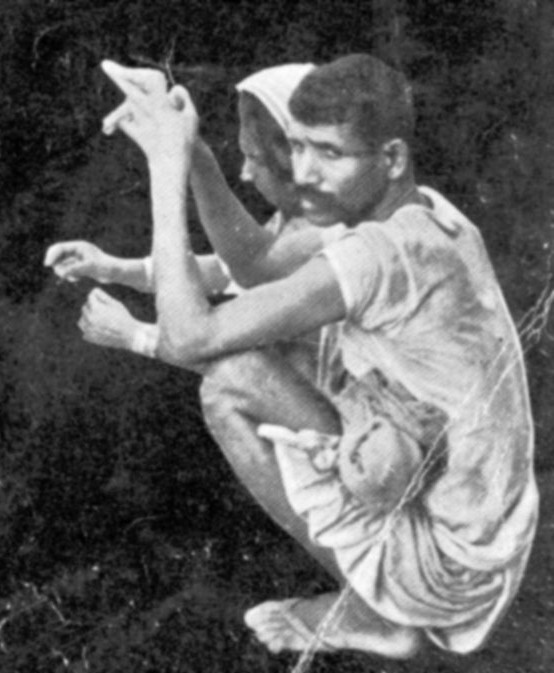 |
||
| Cover photo of Untouchable, by Mulik Raj Anand, Orient Paperbacks, New Delhi, 1970 . | ||
There ends the simplicity. The reality is that there are thousands of castes, subcastes, and tribes. The caste system is always relative, which means that hierarchy (and prejudice), occurs in relation to another caste. For example, the Daivajnas (gold workers), consider themselves better than Acharis, (temple builders), but the Acharis feel the opposite. Obviously discrimination against the lowest castes is rife.
Legally, everyone below Sudra (and even some Sudras) are called "Scheduled Castes" (SC), "Scheduled Tribes" (ST), and "Other Backward Classes" (OBC). This dates from the period of the Raj, when the British colonial administration drew up schedules of those most oppressed and underprivilged. Some groups consider themselves "Dalits"; others do not. Often, individuals and families of an SC, ST, or OBC may wish to identify with "Dalits," even though the entire group may not. In an attempt to create simplicity and clarity where neither exists, we use "Dalit" (and we feel that this is what Dr. Ambedkar ideally intended) to include everyone outside the twice-born. Sudras constitute up to 58% of Hindus, and Untouchables as much as 24%. SC and ST are about 30% of the entire population. Therefore, more than half of India's population could be considered "Dalits," although some sources want to say it is only 16-30%.
Nearly 90 percent of India's impoverished and 95 percent of the illiterate are Dalits. Affirmative action has benefitted less than 5 percent. Even this attempt to "level the playing field" is being hotly contested in India, as it is in the United States. Nasty demonstrations by upper-caste Hindus have demanded "Equal opportunity, not favoritism!" at universities, medical schools, and hospitals, in opposition to government reservations for the underprivileged groups.
In India's modern cities, caste distinctions are often blurred, but in rural areas, where 75 per cent of all Indians live, caste dominates every aspect of life. It determines where they reside, who they can marry, what work they can do, how or whether they get paid, and whether their children can study. Dalits are often denied access to village wells and barred from shops and tea stalls. In public schools, their children face many forms of harassment and discrimination by those ranked above them.
It is interesting to contrast slavery and casteism. Slavery reduced people to chattel; slaves from Africa were bought, sold, and worked like animals. Still, slaves had some monetary value to their owners. Dalits belonged to no one, had no value, and were often not paid wages for their degrading labor. They did low and dirty tasks because it was their "duty." Living on what they could eke out, scavenge, or beg, they had no standing and no rights. They could be killed with impunity. Without monetary value, spiritual value in Hinduism, or education, many Dalits came to believe that they actually were useless and polluting. From what we've read, this perception of self-worthlessness persists in the more backward rural areas even today.
Violence against Dalits is horrific. According to government statistics compiled in the year 2000, more than 25,000 major crimes were committed against Dalits. Another way to understand the figures is that every hour two Dalits are assaulted; every day three Dalit women are raped, two Dalits are murdered, and two Dalit homes are burned. Of course, those numbers are a mere fraction of crimes committed against Dalits. Since police, village leaders, and government officials themselves subscribe to the caste system, most caste-related crimes are unreported.
We read this report in one of the English papers. In a village near Nagpur, the mother and daughter of a Dalit family were gang raped and killed; the son was hacked to death; and only the father survived. It seems that some of the family members had testified against upper-caste villagers in the trial of an earlier crime. It is often remarked that untouchability never seems to matter when it comes to came to sex and rape, but of course, rape is always about power and dominance, isn't it?
For a graphic video of Dalit life, "I'm Dalit, How are you?" visit one of these websites:
<http://politeindian.wordpress.com/2006/10/13/i-am-dalit-how-are-you/> [You Tube] or
<http://www.idsn.org/tekst/movie.htm#> [high quality htm# format]
Dr. Ambedkar had been born into the untouchable Mahar community. Like many Untouchables, his father found his career in the military, under the British. The young lad's great promise was recognized by the reigning Raja, who saw to his education. Endowed with a brilliant mind, he earned advanced degrees from the US and the UK. When he returned to India, after his studies abroad, however, he hit the brick wall of untouchability--he couldn't even find a room to rent in his homeland. He realized that his own trials were nothing compared to the appalling suffering inflicted upon other untouchables, and he determined to do something about it. A man of great rectitude and principle, he never neglected his mission, which inflamed his life and in turn inspired all victims of caste discrimination. He was a towering figure in the movement for an independent India and served as the architect of the Indian secular constitution, a remarkable document.
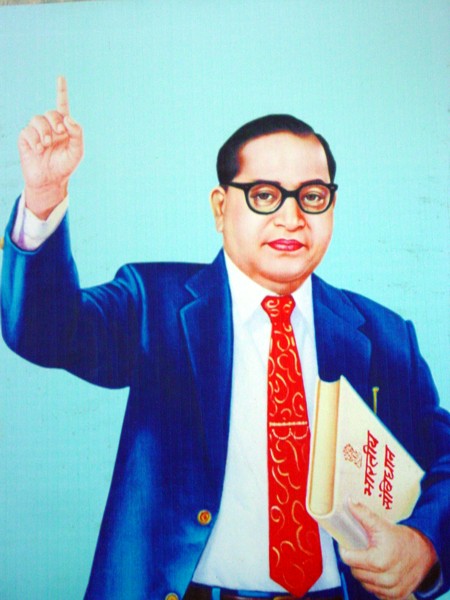 |
||
| Every home and every vihara has a picture of Doctor. Ambedkar near the altar. This poster-size painting was at a small vihara. | ||
Not much known in the west compared to Gandhi, Dr. Ambedkar was the true advocate and adept of non-violence. Gandhi adamantly declared that caste was essential to Hinduism, and, although he advocated improving the treatment of Dalits, he never wanted to change their actual status. Gandhi used the term "Harijan" (meaning children of god), but many considered this offensive. In fact, there is an old Hindu custom of pre-adolescent Dalit girls being forced to become devadasis,"female servants of god." These young girls are"married" to the divinity of a Hindu temple and are "used" by upper-caste Hindus. Since they have already been "married," they are not allowed a civil marriage; in time, they are simply sold to a city brothel.
Everyone knows that Gandhi preached ahimsa, non-violence, but he also carried the Hindu text, Bhavagad Gita, which promotes war as duty on every page. A closer scrutiny of Gandhi's practice reveals that every fast and campaign he led was shadowed by the threat of violent riots if he did not get his way. It is no wonder that statues and photos of Dr. Ambedkar can be found everywhere, while public memorials to Gandhi are few and far between.
Left with no illusions about changing Gandhi's mind on caste, Dr. Ambedkar swore that, although he had been born a Hindu, something over which he had no control, he would not die a Hindu. He thoroughly studied the alternatives--Islam, Christianity, Sikhism, and Buddhism--and finally decided on Buddhism. Fifty years ago, in the town of Nagpur, he took refuge in the Triple Gem and accepted the Five Precepts from Ven. Chandamani, a monk from Arakan. In addition, Ambedkar set down twenty-two special precepts for his followers, including vows never again to worship Hindu gods. Of course, it would take more than just this recitation to overcome the mentality of casteism, but it was a vital beginning.
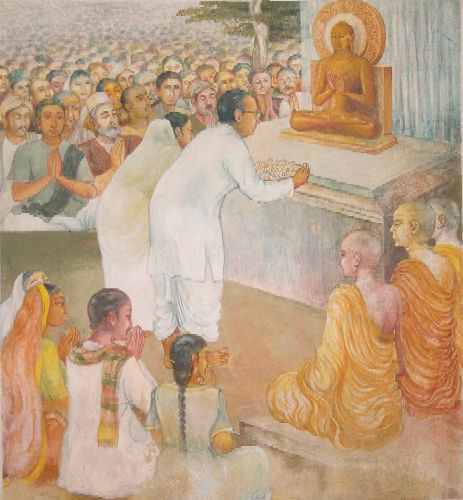 |
Dr. Ambedkar and his wife publicly taking refuge in the Buddha, the Dhamma, and the Sangha, in Nagpur, October 14, 1956. A painting in the Sri Lankan Temple in Sravasti. | |
Khar Station is very small, but the plaza in front of the station is abuzz with activity. Next to a wall, a group were engaged in a "floating crap game" played with little seashells rather than dice. The players seemed to come and go, but the game never ended. Two elderly women sat on the sidewalk carefully stringing flowers into garlands. In another corner, we saw a woman with a crazed look beating a little girl with a stick, and a man was kicking a pariah dog, seemingly from habit. There were many fruit and vegetable stalls near the station with produce more beautiful than we had seen since leaving Japan--piles of tomatoes, carrots, potatoes, cauliflower, apples, oranges, pomegranates, and much more--and all so cheap! Still, we saw many children with swollen bellies and almost blond hair--obvious signs of malnourishment. Though it is possible to survive on a few rupees a day, those street kids were hardly thriving.
There were many old black and yellow taxis waiting in front of the station, but Bhante had to ask several drivers before he found one willing to take us to the part of Mumbai where we wanted to go. As we drove along, Bhante described the flood that Mumbai had suffered in July 2005. Much of the city had been under eight to ten feet of water. Santa Cruz, near Khar, was one of the worst affected areas. We could still make out high water marks on some buildings. Thirty-six inches of rain fell in a twenty-four hour period, with more than twenty inches within four hours. More than one thousand people died in the deluge. Survivors from the nearby slums had scrambled to the raised railway line, where they spent several days without food or relief, surrounded by filthy water. When we visited, Sanghamitra Vihara, Bhante's monastery in New Mumbai, we learned that the building had filled with water and that all the Buddhist books and papers kept there had been ruined.
Bhante explained that the upasaka to whose home we were going was the manager of an apartment building in an area named Brahmin Vadi, though it is now occupied mainly by Muslims. His family, of course, are Dalits, as are most of those on the upper floors of the building. The Brahmins, who occupy the ground floor, were upset that, during the flood, he had opened the building to all as a haven, certainly saving many lives. We could see the water mark at least six feet high. Knowing the condition of the sanitation system and the toilets, one shudders to think about the water swirling through the city, rising faster than the clogged, inefficient sewers could carry it away. This disaster was only a few months before Katrina, but went largely unnoticed by the rest of the world.
That satisfying lunch in Mumbai was the first of many that we enjoyed with Buddhist families in homes all over Maharashtra during our three-week stay. Invited with. Bhante, we enjoyed warm hospitality and delicious food, and learned about our hosts' lives and aspirations. As we joined them in vandana, we were impressed that, just as in Burma, the older children assisted in serving the monk, and the younger children were being taught how to respect the monk. That day in Mumbai, the children had stayed home from school in order to meet Bhante.
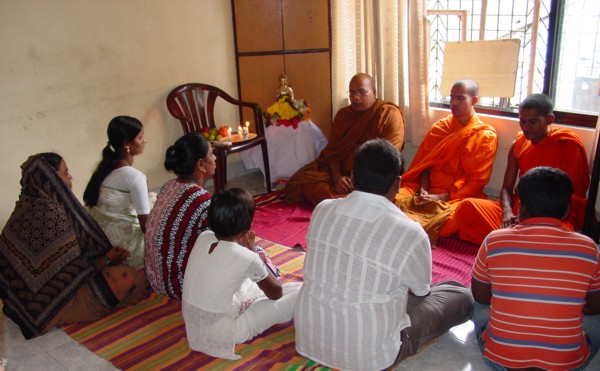 |
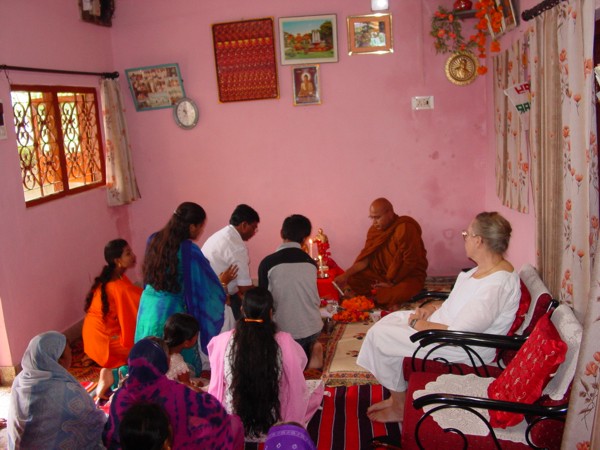 |
|
Every day, Bhante patiently taught Dhamma, sometimes subtly, sometimes humorously, but always clearly. Many of the families we visited had participated in Dhamma camps and practiced meditation. Some of the adults and young people had even ordained temporarily as samaneras and samaneris. In one family, we were very struck by the devotion shown by the younger son. Bhante told us that that boy has often said to his father, "You have another son, please let me become a monk," but that his father continued to object. We are working with Bhante to find several Indian boys to become novices and come to Sri Lanka to study Pali and vinaya in Kandy where we can help look after them and encourage them in their studies. This would be one more step in advancing the Sangha in India. Of course, the real need is to establish reputable bhikkhu training centers in India, but that seemed to be some time down the road.
When traveling with a monk, it is important (and convenient) to keep a regular schedule. Each morning, we ordered breakfast from room service in the hotel. While we waited for it to be delivered, we peeled and cut fruit--apples, pears, oranges, bananas, wood apples, or pomegranates. Invariably, when we took the tray to Bhante's room, usually about seven o'clock, we would find him already deeply engrossed in work, talking on the telephone or surrounded by papers and envelopes ready for the post office. Lunch at about eleven o'clock was sometimes at a devotee's house and sometimes at a restaurant. We were grateful that whenever he was invited to someone's home, he always informed the host that he preferred his food (and ours) without chillies.
At one point, early on, Bhante asked us to explain to the devotees how we converted from Christianity to Buddhism. Visakha related that, even as a child, she had had an unmistakable realization that there could not be an omnipotent creator god in such an imperfect world. Once she saw that, she could no longer accept Christianity or any other theistic religion. Ken explained that in college he took a course on modern Protestant theology. By the time he had finished the research and written a paper on Karl Barth's concept of grace, for which he received a decent grade, he realized that he could not believe any of it. We both had drifted along as agnostics until 1979, when we arrived at Sanchi, where we realized that we were indeed Buddhists. After that, Bhante often incorporated this personal explanation into his talks.
Although our days were filled with ceremonies, meetings, and visits to local viharas, they often ended early, allowing us time with our computers in the evening, for writing notes and downloading photos. We also watched TV in our various hotel rooms, though English was scarce, except, fortunately, in Nagpur, where we spent the most time. News was almost exclusively about India (or Pakistan, as it related to India). During the three weeks, we heard not a word about the war in Sri Lanka. Even the newspapers mentioned it only rarely. If anything, India seemed as insular as the American media. The most popular programming was undoubtedly Bollywood movies. You have to see them to believe them. The dances are never-ending. As you flip through the channels looking for a decent program, you see so much dancing that you can't tell whether it is the same movie or a different one. Sometimes it is in a modern setting; sometimes it is Maharajas in "exotic" costumes, but the dancing is always the same--loud and fast, with the same choreography for the cast of thousands. Perhaps the most extravagant dance number took place on a long narrow gauge train as it descended from the hills, across bridges, with beautiful scenery in the background. Not only were the flat cars full of dancers in tribal costumes, but there was another troupe on the roofs of the boxcars for the whole length of the train, flirting, teasing, shaking, jumping, and dancing. Using the remote, Visakha flipped through all eighty-five channels twice, and they were still at it! These movies presented India as such a happy and joyous place, which just didn't fit with the reality we saw everyday. It was an interesting phenomenon that most of the faces on TV were light skinned, even though a large percentage of the population was fairly dark. There were also many ads for products to lighten the skin and get rid of dark spots.
Much in the news was the amendment to the anti-conversion bill passed by the conservative government of Gujarat. This amendment declared that Buddhism and Jainism are a part of Hinduism. The amendment does not prevent conversion from Hindu to Buddhist; it effectively denies it, which frustrates the Buddhists, and Jains, who do not want to be counted as Hindus.
The issue of "conversion" actually raises an interesting question. Dalits are outside the castes of Hinduism, so how can they ever be considered Hindus? If they are not Hindus, why are they counted and classed as such? Furthermore, if they are not Hindus, they are not really "converting," so why the fuss? There is no end to the nonsense promoted by fundamentalist Hindus!
Another interesting note is that, although casteism is a characteristic of Hinduism, it persists in Christian and Muslim communities in India. Bhante observed that, although Islam everywhere else in the world is a classless religion, when it entered the Sub-continent, it was polluted by the Ganges River. Likewise, certain Christian churches practice discrimination toward lower castes. Only Buddhism has erased this stigma in modern India, just as Buddha had in his time.
We got seen off at the station by the same people who had waited hours for us at the airport. This was much nicer, because we had a chance to talk about everyone's plans. They gave us flowers and we gave them boxes of special Sri Lankan tea and packets of cinnamon (Sri Lankan's the best!) On the ride from Mumbai to Nagpur, we shared a compartment with two men working for Mahindra Motors, a company which makes tractors, among other machines. Their employer had sent them to Thailand, Singapore, and Malaysia, so they really wanted to talk with us about travel. Both were actively involved in the labor movement. They expressed exasperation over the dearth of honest leaders in the political parties. Being concerned with labor and human rights issues, they were very sympathetic with the Dalit movement.
 |
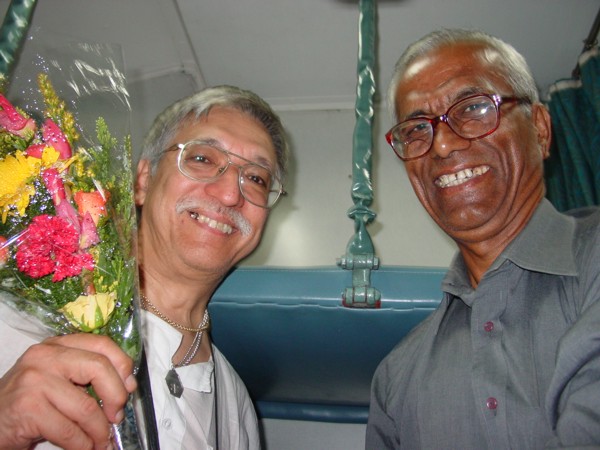 |
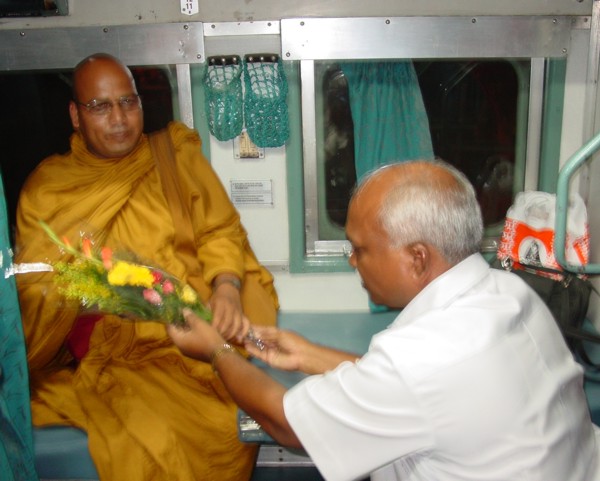 |
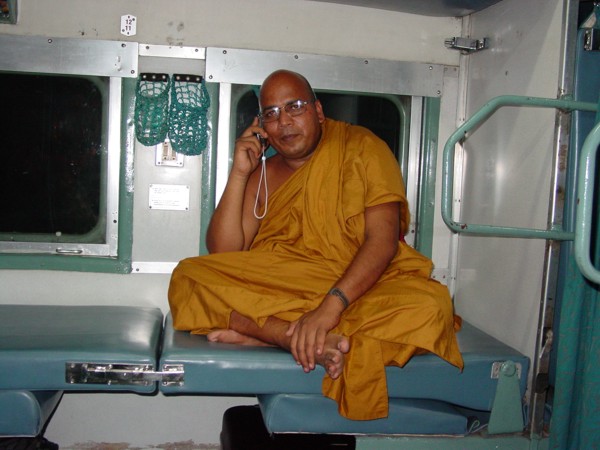 |
||||
|
The train to Nagpur
|
|||||||
When we arrived in Nagpur, we were impressed to see many tuk-tuks with large Buddhist flags flying proudly. Even casual encounters were punctuated by either palms together or salutes and resounding "Jaya Bhim!" which is short for "Victory to Bhim Rao Ambedkar!" One day, when the three-wheeler Ken and Visakha were in stopped at a corner beside another three-wheeler, as soon as the other driver caught Ken's eye, he rather surreptitiously, it seemed, put his hands together and mouthed "Jaya Bhim!" Ken returned the silent greeting, but he wondered how the driver knew.
Nagpur is the geographic center of India. The city, with a population of one million is set to become a cargo hub for all of India and to double in size within a few years. Actually, that happened for the few days of the Golden Jubilee. As our pictures verify, there were indeed two million people on the streets and inside the grounds of DeekshaBhumi. Tribals, village people, and entire families from the big cities arrived in droves. They may have come by train or bus, but around town, most walked everywhere and stood for hours in queues to get inside the great stupa.
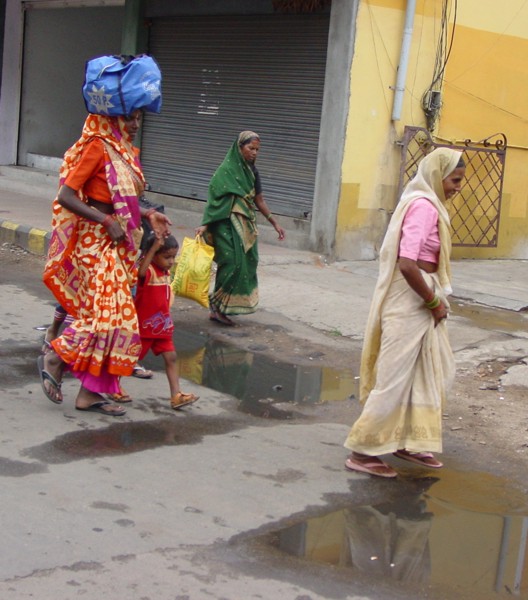 |
 |
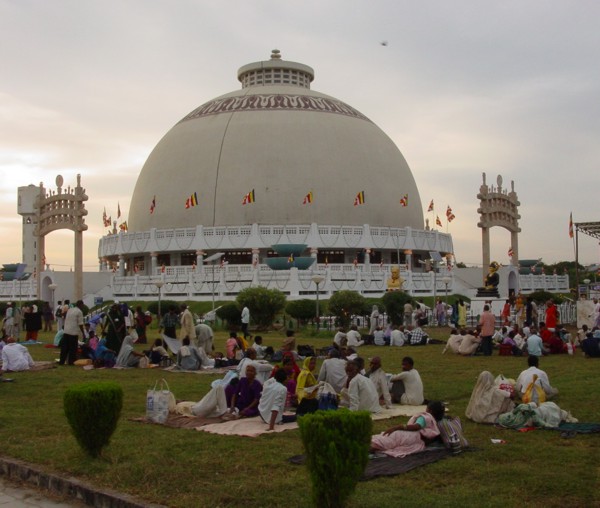 |
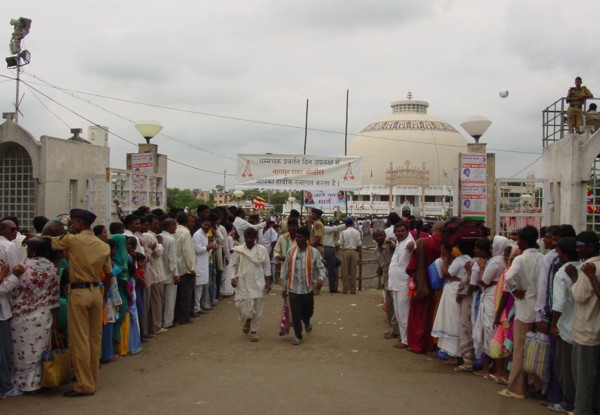 |
|
Unfortunately (for our peace of mind), the dignified Golden Jubilee was not the only thing going on in the city. There was also a Durga festival continuing for ten days with music, dancing, and lots of noise all night long. One over-amplified site was across the street from the hotel, but the loudspeakers seemed to be inside our bathroom. Like all Hindu gods and goddesses, Durga is a fantastic figure, an all-powerful female created to kill an evil demon. She is sometimes described as the Eternal Mother, who destroys the demon, symbolic of the final confrontation of the spiritual urge of man with his baser passions. Durga also plays a part in the Ramayana, giving Rama the secret of how to kill Ravana, the ten-headed king of Lanka who had abducted Sita. (Lest we think that Hinduism reveres women, remember that after Sita was "rescued," she was forced to walk through fire to prove her "purity." Deepa Mehta's movies "Fire" [1996] and "Water" [2005], both of which were banned in India, illustrate the point clearly.)
As we rode around Nagpur, we kept passing stalls set up on the sidewalk selling chandeliers, ceramic pots and flowers. We wondered why chandeliers were being sold like this, rather than in electric stores. One night, when Ken happened to look out the hotel window to try once more to understand why the noise was so loud, we found out. There was a procession, accompanied by music and firecrackers. People were carrying the illuminated chandeliers above their heads. Others were holding aloft fluorescent tubes, and all were connected by wires, connected to a generator or battery, but we did not see that. It was part of the Durga festival, but Bhante told us that the chandeliers are also carried in wedding processions.
We were very comfortable at the Blue Moon Hotel, near Nagpur Railway Station and across from the Mayo Hospital. Many of the staff were Dalits and took very good care of us. We stayed there for ten days, and everyday at least one group of devotees visited Bhante. In addition to citizens of Nagpur and other cities in Maharashtra, we met many Buddhists from Bangalore (Karnataka), Gujarat, Kerala, New Delhi, and BuddhaGaya (Bihar). One middle-aged doctor from Ahmedabad had twice, as a young man, run away to Bangalore hoping to ordain. Each time, his father had caught him and forced him to return home to finish his studies. Thwarted in his plans, he had married and had children. He has now become a stalwart pillar of Gujarati Buddhism, and, to his great joy, he was at last going to be ordained, at least for a few days, as a novice in the huge ceremony at DeekshaBhumi.
Sometimes we used two tuk-tuks (one for Visakha and Ken; another for Bhante and the wheelchair). Sometimes Bhante hired a van for the day. However we went, we were amazed at the traffic. There seem to be no traffic rules whatsoever in Nagpur. Of course, we expected the insane mix of buses, trucks, vans, cars, taxis, tuk-tuks, motorcycles, ox-carts, pedestrians, cows, donkeys, and horses; this is India, after all, but the chaotic indifference to lanes, traffic signals, and signs astounded us. Many of the roads were half closed because of construction, perhaps related to the birth of the "hub," but that did not prevent people from sleeping everywhere, including the narrow raised median between lanes of rushing traffic.
Every day we passed the Zero Mile Post (geographic center!). Across the street were some cool statues from the British period--powerful horses emerging from the ground (wonder about the symbolism). This part of India was ruled by tribal chieftains, who, as the name of the city indicates, worshiped Nags or snakes. After it became Buddhist, the reverence for Nagas was retained and incorporated into Buddhist art.
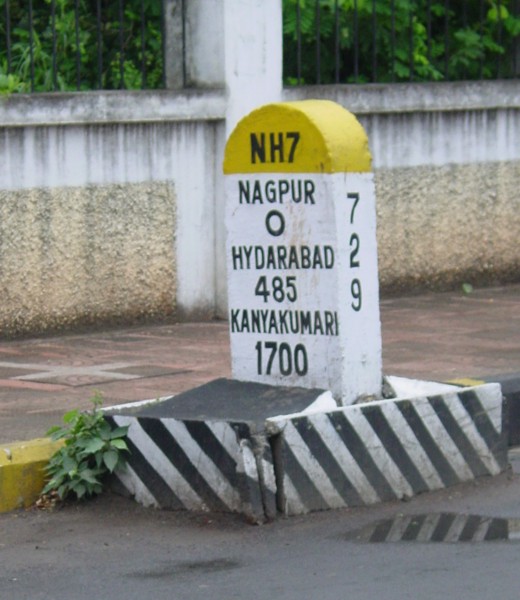 |
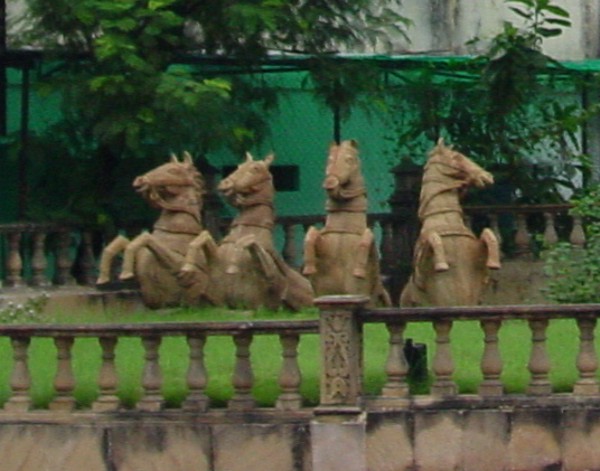 |
|
Many of the activities for the Golden Jubilee in Nagpur were organized by Ven. Shurei Sasai, a Japanese monk, now an Indian citizen, who has lived in India for more than forty years. He is very respected and has even become politically influential. A huge white tent with lights and ceiling fans was erected in one corner of the DeekshaBhumi grounds. For two days this was continuously packed with four or five thousand people and about one thousand were ordained as samaneras (novice monks) and samaneris (novice nuns). The first night we were there, we were able to sit in chairs, and we met many who were going to ordain when they came to pay respect to Bhante. One was a documentary maker who had created three programs about Dalits for the BBC. The next day, however, everyone sat on the ground, and Visakha was very glad she had her wheelchair to stake out a place. She was surrounded by hundreds upon hundreds of shaved heads. Somehow, each person seemed to know exactly when his or her ceremony would take place. They all waited patiently and observed the other ceremonies. (We wondered whence had come all the robes and learned that most had been donated by Thais. We also wondered why no enterprising Indian has begun a company producing these robes [and bowls] locally.) Accompanying these eager initiates were many proud family members. Near where Visakha was sitting, Ven. Dhammadina, an active Nagpur nun, was looking after a large group of girls who had shaved their heads. Later, we learned that Ven. Dhammadina very much hopes for higher ordination in Sri Lanka. We hope this can happen and that we can help her in realizing this goal.
 |
 |
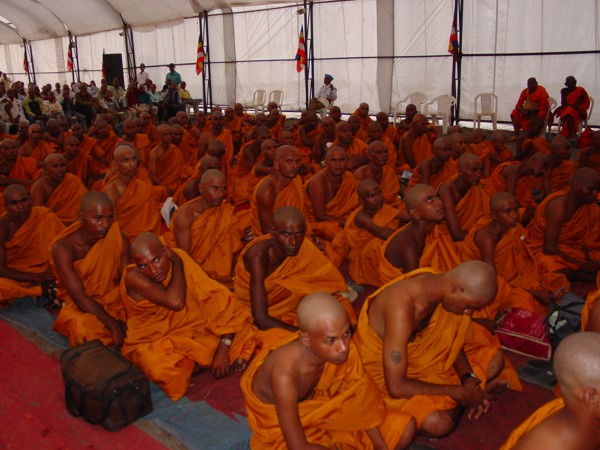 |
|||||
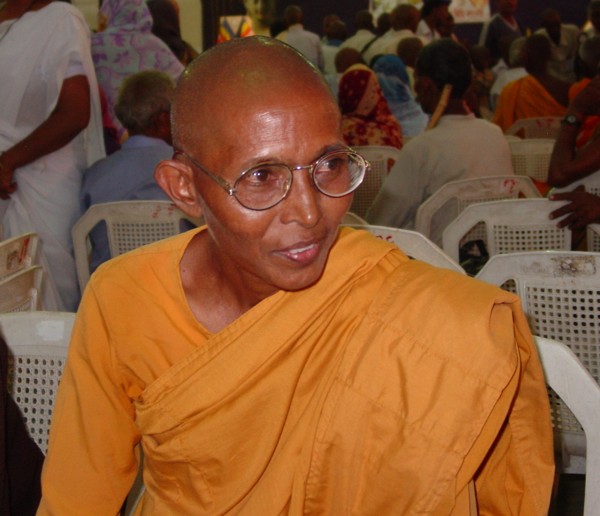 |
 |
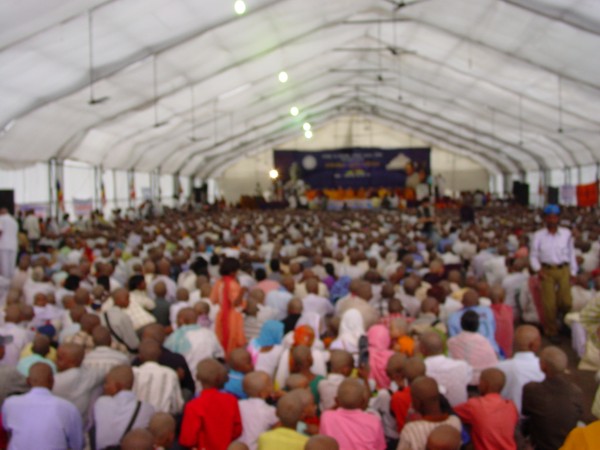 |
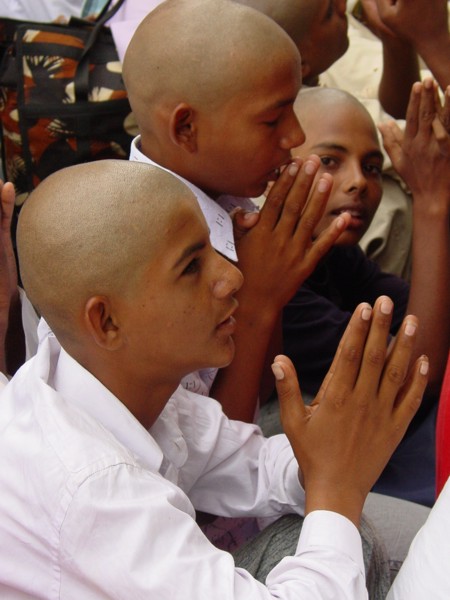 |
Top left: Ven. Sasai Bottom left: |
|||
At the other end of the grounds, a large dais had been erected to serve as the scene of the formal ceremonies. When we arrived at dusk, the entire grounds of the DeekshaBhumi were packed The area in front of the dais was covered with orange-robed novices sitting on clothes on the ground. We were escorted up and seated in the back, where Visakha insisted on staying, even after Ken and Bhante were compelled to take seats in the front row. Early in the proceedings, Ken's and Visakha's names were announced, and Ken was presented with the first of many garlands. (Visakha twice refused a garland as she sat in the back.) Ken was even asked to give a speech, which he kept very short and simple to translate. Other speeches were not so short, and few were in English. A Sri Lankan monk from Canada described his impressions on the revival of Buddhism in India. A Thai monk who had recently completed a Thai translation of a biography of Dr. Ambedkar spoke very eloquently. The VIPs included Vietnamese supporters of Sasai Sensei and Taiwanese Buddhists who are active in printing many books in local languages, including Marathi and Karnata. Several Japanese priests, in their black, gray, and brown robes, gave speeches in formal Japanese, which Sasai Sensei translated into Hindi, and some lay people who had come with them sang a Japanese Buddhist song. Almost as soon as they had finished, they left the dais and were replaced by another group of Japanese from a different sect, who also gave speeches. Some of the speeches in Hindi or Marathi seemed to have political overtones, but without a program or English translations, we could not be sure of their content. We wondered whether the program would continue until midnight or later. It showed no sign of weakening when we left about ten.
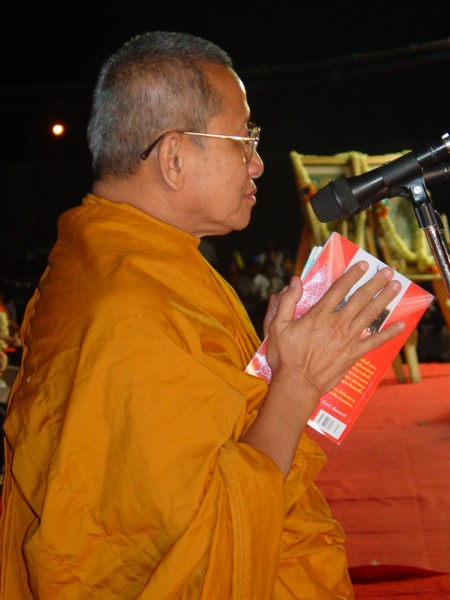 |
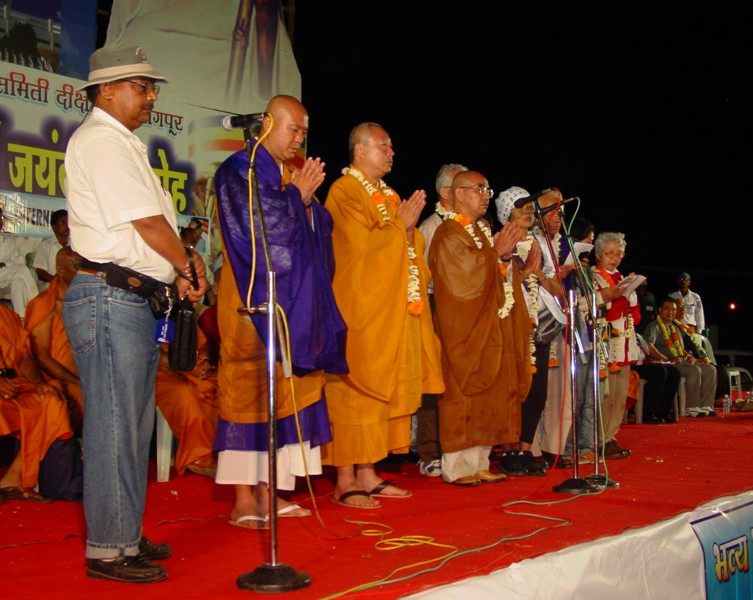 |
|
We seemed to be the only westerners in Nagpur. In fact, except at a five-star hotel in Mumbai (where we went to use the wireless internet), and the last day at our humble hotel near Khar Station, we saw no other westerners the whole time in Maharashtra. We were, however, delighted to meet the photographer, Munesuke Yamamoto, whom we had first met many years ago on the Thai/Burma border. He had gotten to know Sasai Sensei last year, and was spending several weeks with him. Small world, isn't it?
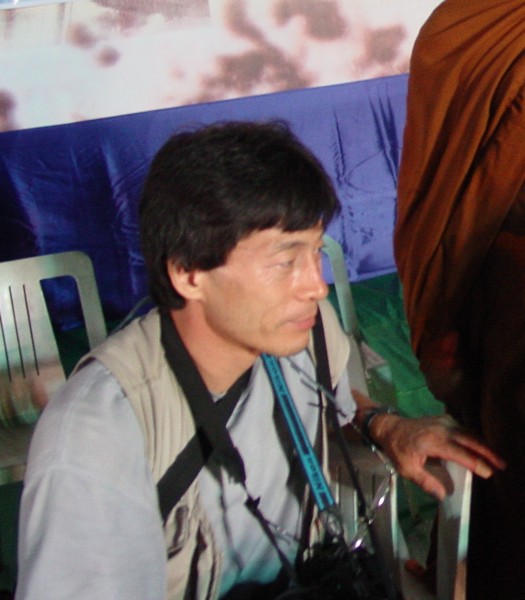 |
||
The next morning we were back on the dais. There were at least ten times more people than there had been the night before. The Great Stupa seemed to rise out of the sea of humanity. We had heard that Nagpur was going to be sweltering, but, fortunately, the sky was overcast. There was even a slight breeze, so we did not mind that there was no canopy. Shortly after we arrived, novices climbed onto the dais and completely filled the back tier. There must have been about three hundred. The seats on the front tier were occupied by a few senior monks and about 50 representatives of various groups, tribes, castes, and communities, who were publicly converting to Buddhism. The conversion for their followers, as many as 350,000, would take place in December. This was indeed a moving ceremony. After everyone (remember, two million people) had taken refuge in the Buddha, the Dhamma, and the Sangha, and had repeated the five precepts, Sasai Sensei recited the twenty-two special precepts formulated by Dr. Ambedkar, and the leaders repeated them, severing all connection with Hinduism.
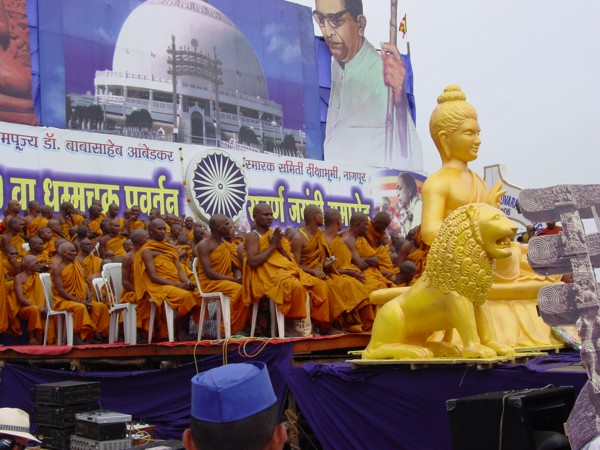 |
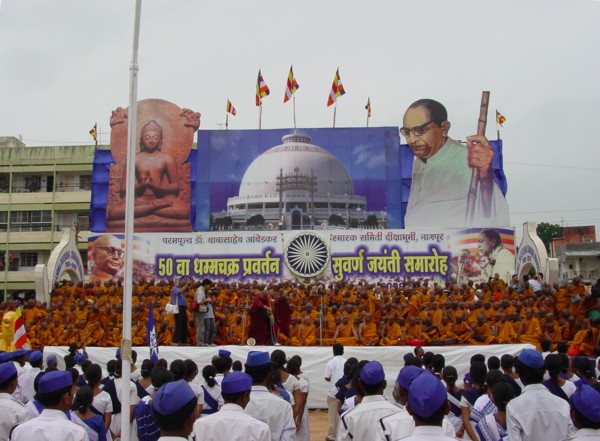 |
Left: Samaneras seated on the dais Below: |
|||||||||
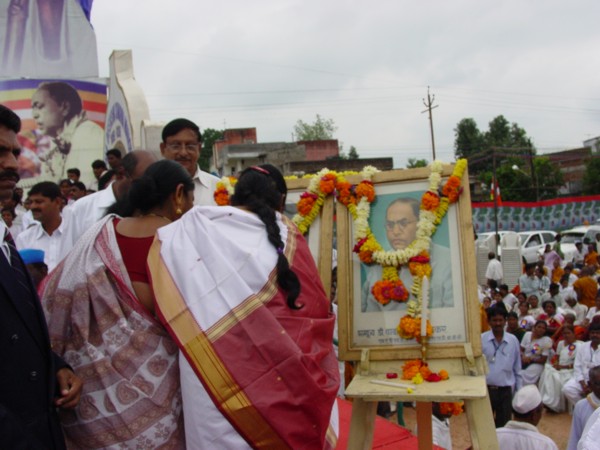 |
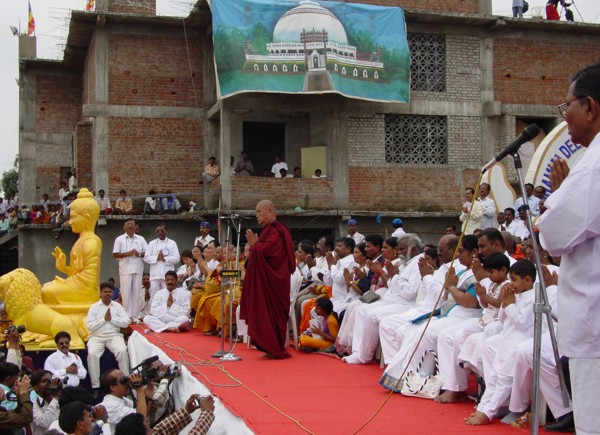 |
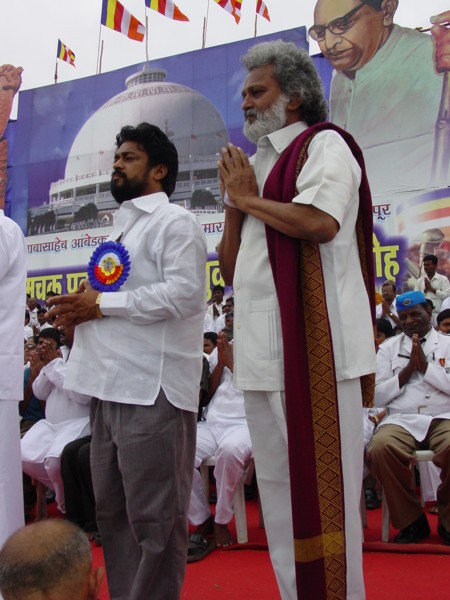 |
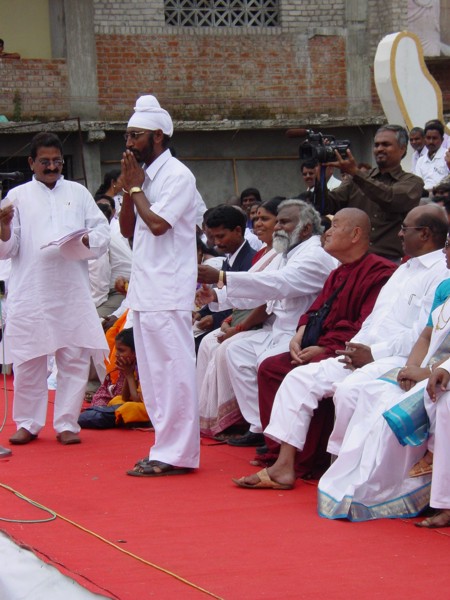 |
||||||||
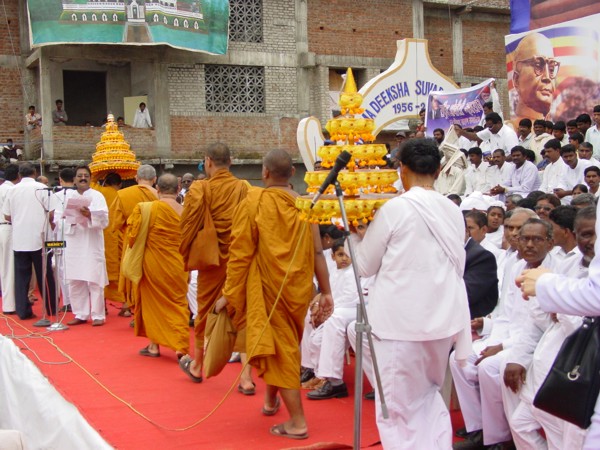 |
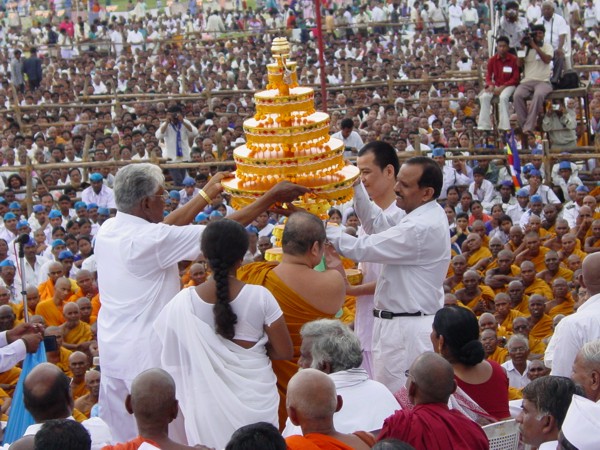 |
Left: Thai monks donated golden umbrellas Below: |
|||||||||
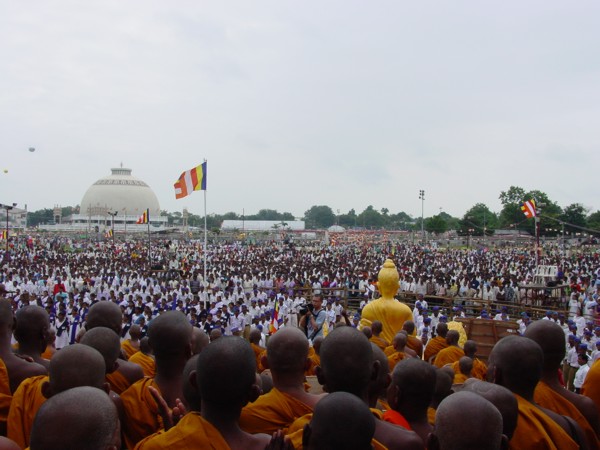 |
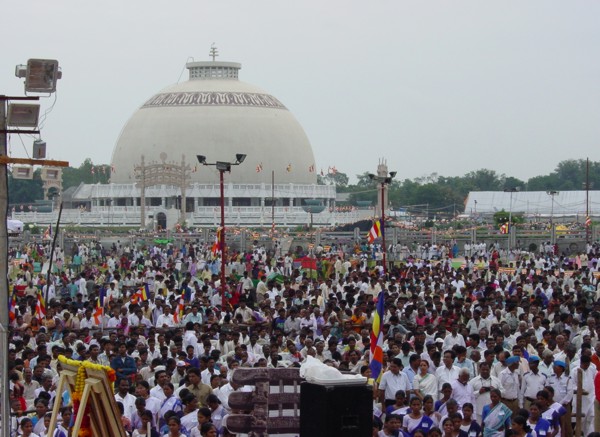 |
 |
|||||||||
The morning activities concluded with our launching a book of essays on Dr. Ambedkar written by our friend Mr. Jagtap, who visited Sri Lanka with Bhante early this year. It was great fun cutting the ribbon on a pack of the books and seeing the smile on his face as he passed them out. He has also finished a translation of The Buddha and the Sahibs, a fascinating book about how English civil servants helped to bring about the rediscovery of Buddhism in India, but he is waiting for permission from the author to publish.
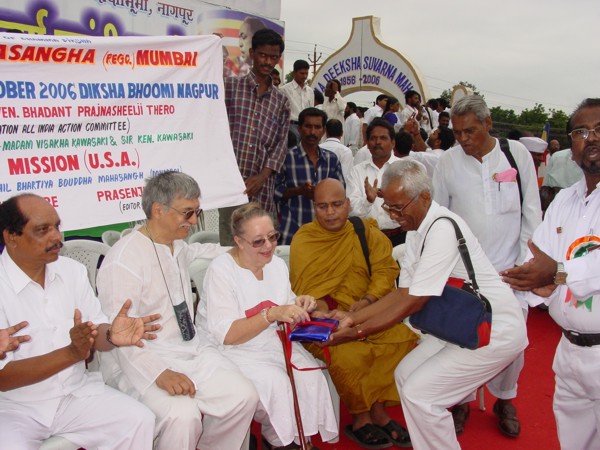 |
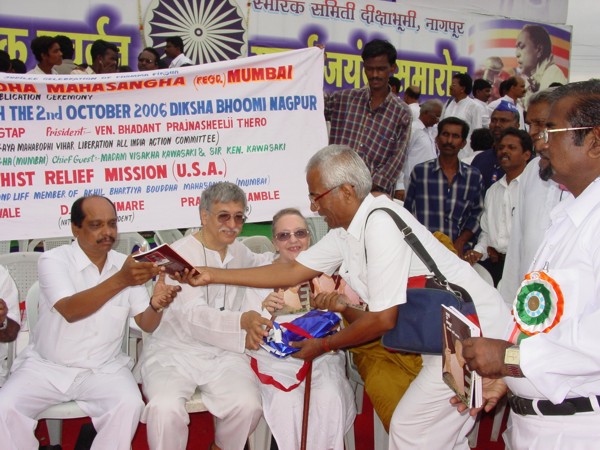 |
 |
|||
|
That's Mr. Jagtap with the blue bag!
|
|||||
For the two days of formal ceremonies, the streets leading to the entrance of DeekshaBhumi were closed to traffic. For much of the way, the streets were lined with stalls. Most were selling books, Buddhist images, clothes, bags, pendants, posters, CDs, and a myriad of items related to Dr. Ambedkar. Others provided information about and solicited support for Buddhist and Ambedkarite organizations. Still others were distributing food to devotees. We passed one truck where Thai volunteers were passing out lunch trays. On the sidewalk nearby, novices were enjoying the delicious food.
It was difficult to proceed smoothly and quickly along the street to shop, not because of the crowds, but because, every few feet, someone stopped Bhante to pay respect, greet, discuss a burning issue, or offer an invitation to a meal or a ceremony. One young man informed Bhante of a ceremony in Mansar (about one hours from Nagpur) in which Christians, Muslims, Tribals, and even a Punjabi family were going to convert to Buddhism. He asked if Bhante could join. He assured the young man that we would be there. After he had left, Bhante explained that this young man used to catch venomous snakes and to ride through small villages on his bicycle performing as a snake charmer. Subsequently, he had become a novice and had helped Bhante for several years. We took many photos to help us remember these fascinating characters, and many people asked to have their pictures taken with us. Bhante also passed out thousands of the flyers he had printed calling for action on the return of the MahaBodhi Temple to Buddhist control, a campaign he has been active in for many years.
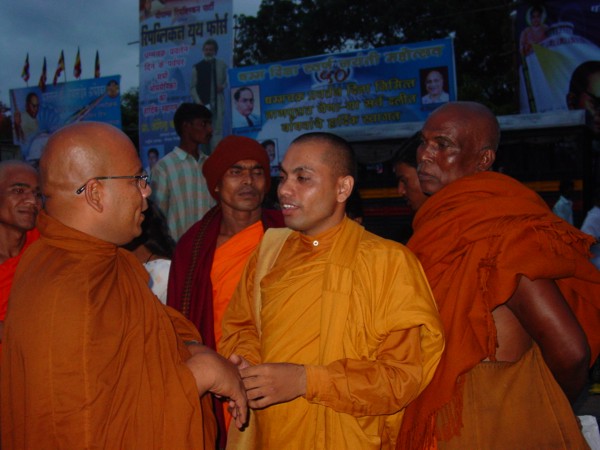 |
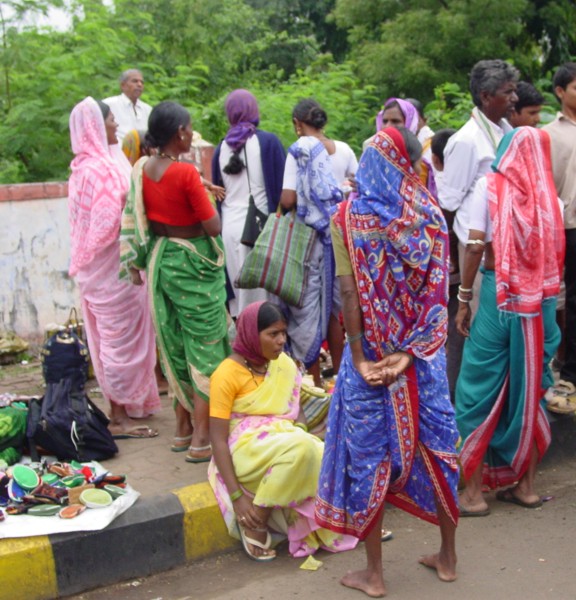 |
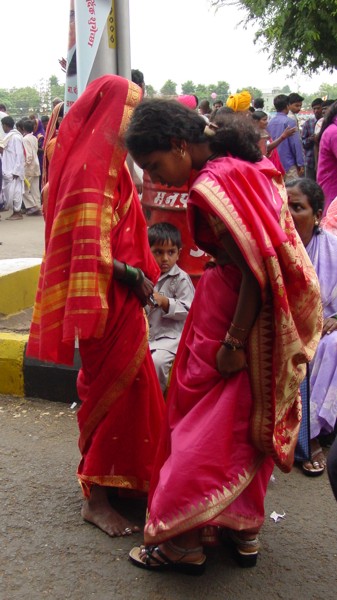 |
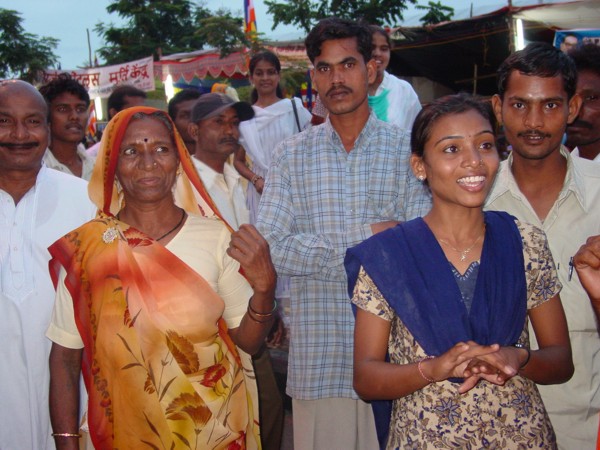 |
|
One day, we had a free hour, so we went to the Nagpur Central Museum, reputed to be the oldest museum in India. Most of the exhibits were minor and of not much interest. One small gallery, however, contained a few Buddhist images. One in particular was magnificent. It was a bronze standing Buddha from the fifth century--very early for an Indian bronze. It showed remarkable craftsmanship. We wanted a photo, but that was clearly prohibited. No postcard was available. We asked politely at the reception desk, and the clerk suggested we talk with the Director of the Museum. While Visakha waited patiently in her chair in front of the Buddha, Bhante and Ken went to the Director's Office. A few minutes later Ken returned to summon Visakha into the office for tea. We spent about a half an hour in the office. The Director was a very interesting man. He was a Buddhist from Nagpur. He had studied in Nagpur and had gone to Delhi for his graduate work. After joining government service, he requested and was happily assigned to the Nagpur Museum. He spoke at length about the carelessness of the Patna Museum, where a number of priceless Buddha images had just been stolen. In fact, he said, India's Buddhist heritage was being shown little regard. As an example, he mentioned the Buddhist excavations at Mansar which had been overseen by a retired archeologist, Dr. Sharma. Dr. Sharma, he said, was notorious for claiming that purely Buddhist sites were Hindu and for packing away archeological evidence to the contrary.
The Director was very pleased that we were so interested in that Buddhist image, obviously one of the prize possessions of the museum. He informed us that that image has been selected to appear in a very important exhibit in Paris next year. Final negotiations are currently being held. As we were drinking our tea, he commented, "How can I refuse you permission to photograph that image?" and instructed his assistant to accompany Ken to the gallery
One of the visitors to the hotel was a man with his daughter who brought flowers for both Bhante and us. (We received flowers almost every day, and kept them in water in our room.) Bhante knew the family very well, and the man wanted to invite him for a fifth-year memorial service for his mother. Bhante agreed to accept lunch at his house the next day.
After Bhante had finished the service and lunch had been served, a car suddenly arrived and there was a flurry of activity. Then a bearded man, completely stooped over, came inside. He was wearing a short sarong, but no shirt. The reason he was stooped, we realized, was that he was wearing restrictive shackles, similar to those we had seen in the Burmese prison museum, but much shorter. The family seated him in a corner and treated him with respect. At first, we wondered whether he was a convict, released temporarily for the ceremony. That seemed unlikely since there was no guard to be seen. He also seemed too cheerful for that. He accepted a glass of water, but refused the meal. Later, he accepted a small piece of fruit. He sat cross-legged in the corner all the time we were there, but an explanation of his situation had to wait until we left. Some years ago there had been a young man who might have been suffering from Pteriidae Syndrome. His family could not control him and he constantly shouted in very foul language. Of course, at that time in India, there was little understanding of mental illness, and no medical care was available. His desperate parents finally shackled him and kept him confined. Eventually, his mental illness abated, and that was regarded as a great miracle and was attributed to the shackles. After his death, people began to think of him as a saint, and to imitate him by shackling themselves. It may be becoming something of a cult in Nagpur, tenuously related to the Ambedkarite, but certainly not to Buddhism. This man said he had been wearing shackles for four years, but we saw no reason to believe that he kept them on around the clock. There are many kinds of people in this world!
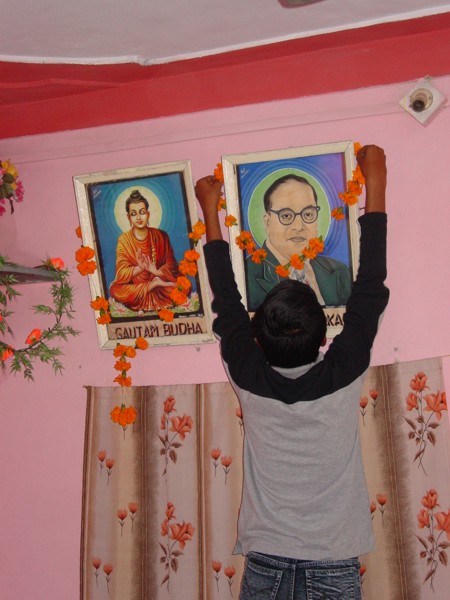 |
 |
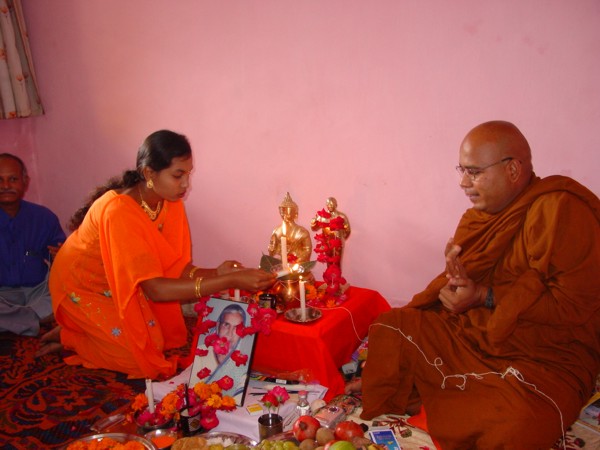 |
|||
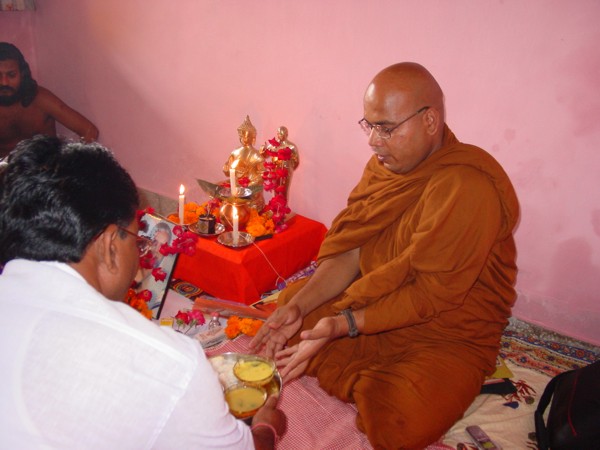 |
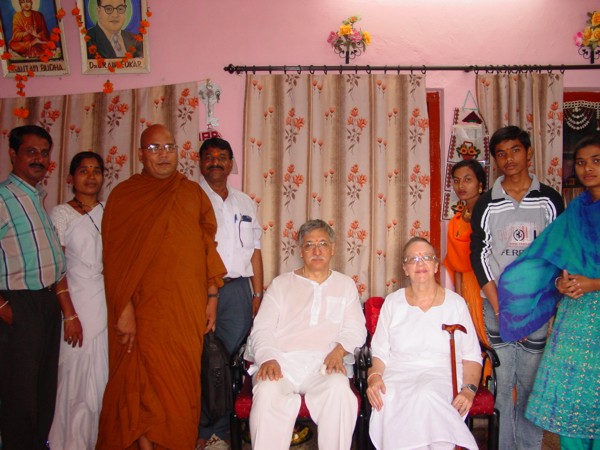 |
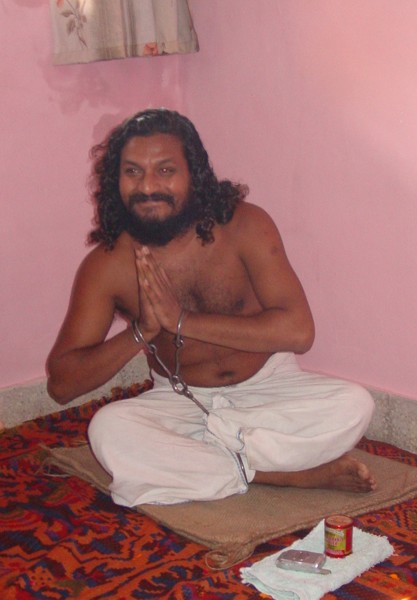 |
|||
That afternoon there was a joyous parade, which we watched standing right in front of the hotel. There were hundreds of lorries, elaborately decorated with flags, banners, placards, colored streamers, and tree branches, and loaded with thousands of pilgrims and newly-ordained novices. In some of the lorries, costumed characters stood in tableaux with scenes from the life of the Buddha. Mingling with the lorries were motorcycles bearing large Buddhist flags and excited devotees on foot shouting "Jaya Bhim!" and stirring up the spectators. Because of the traffic, which never completely stopped, the parade moved very slowly, so that the ox carts did not appear at all out of place. One truck had a big eye painted on the gas tank cover plate. (To keep thieves away?)
(To be continued)